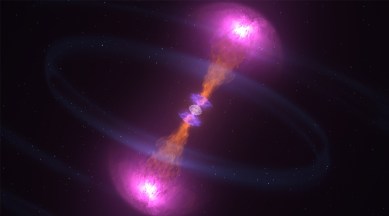Astronomers may have finally discovered source of mysterious fast radio bursts: Reports
Scientists may finally cracked a long-standing astronomical puzzle—what is the cause of a mysterious kind of radio signal known as fast radio bursts.

For years, astronomers have been confounded by a special kind of radio signal–fast radio bursts— and its source. But now, scientists may have found what causes them—neutron stars collapsing into black holes.
What are fast radio bursts?
Fast radio bursts are intense but short radio signals that last for milliseconds. While astronomers have had working theories about what could be causing these signals, they simply haven’t been able to accurately pinpoint the cause. That may have changed now.
monthly limit of free stories.
with an Express account.
Collapsing neutron stars and fast radio bursts
In a research paper published in the journal Nature earlier this month, astronomers studied two neutron stars colliding and turning into a black hole, generating a burst of gravitational waves. And not too long after, this event seems to have produced a fast radio burst.
A neutron star is the remnant of a collapsed supergiant star that was between 10 and 25 times the mass of our Sun. To put it simply, as per Futurism, the merging of two such neutron stars may have caused the strange radio waves.
Unlike a neutron star, a black hole does not have a magnetic field. According to ARS Technica, the fast radio burst could have been generated when the strong magnetic field of a neutron star ceases to exist.
Limitations of the new explanation
While this new theory does seem to explain the source of fast radio bursts, currently, it can only truly apply to the fast radio burst that was discovered in June this year–FRB 20190520B. But even though that particular signal was similar to an earlier one discovered in 2016, scientists can’t definitively say that this hypothesis of a collapsing neutron star applies to both or indeed, all fast radio bursts.
These two radio bursts share an interesting similarity–they both seem to emit weaker radio waves in between the stronger pulses.
However, the similarities between these two FRBs could help scientists solve the puzzle. Yu Wenfei, from the Shanghai Astronomical Observatory, told Space.com that he is optimistic that investigating such extreme fast radio bursts could prove to be the key to solving their mystery.
But there is another issue. According to Clancy James, co-author of the latest article published in Nature, there are not enough merging neutron stars in the universe to explain the number of fast radio bursts.
So, there is also the possibility that different fast radio bursts are coming from different sources. James writes that some of these radio signals might be coming from magnetars, neutron stars with a exceptionally powerful magnetic fields.